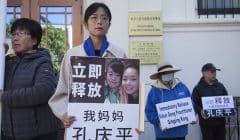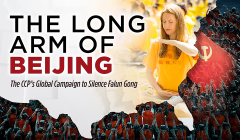One Regime, Two Faces
Violence and terror against Falun Gong and others belies increasingly polished global image of CCP
With his hands tied behind his back, 36-year-old Mr. Liu Yonglai lay naked and shivering on the floor. The smell of burning flesh was in the air.
After dousing Liu with ice-cold water to intensify the electric currents, several labor camp guards shocked his body with electric nightsticks – each of which emits a 36,000-volt charge – targeting sensitive parts of the body such as the mouth, neck, anus and genitalia.
In the hallway just outside, other victims lay moaning or vomiting from similar torture.
On the other side of the camp, 60-year-old Ms. Fu Shuying, 27-year-old Ms. Chen Hui, 30-year-old Ms. Sun Yan and others are tied up in a spread-eagle position as torturers repeatedly thrust long rods into their vaginas causing severe inflammations and bleeding. Other women suffer similar tortures with toilet and shoe brushes.
All the while, loudspeakers blare out fierce propaganda, aiming to unseat the victims’ personal beliefs and instill in them the Party line.
The combined methods of extreme violence and constant shaping of thoughts are what the torturers call “re-education.”
Several have already died here from this “re-education.” More will surely follow.
And what is this grisly scene? Early 1950’s China, perhaps, when the newly victorious Communist Party sought to seize property by killing the landlords, and often, their entire families? Or maybe 1960-70’s China during the Great Cultural Revolution where the Communist ideal of “social struggle” was transformed into the torture and murder of millions?
In fact, this is 21st Century China. Spring of 2003, to be exact, at the Dalian Forced Labor Camp, one of hundreds throughout China where police and guards are under orders from the Communist Party’s highest authorities to use “any means necessary” to coerce practitioners of the traditional Chinese meditation, Falun Gong, to renounce their faith, and swear allegiance to the Party line.
Change, or a Face Lift?
Many would argue that today China is different, or at least, changing. Admittedly, the PRC as we view it today looks nothing like that of Maoist China. Shanghai’s skyline rivals that of any international city. The Olympics are coming to Beijing. And nobody is waving Mao’s little red book anymore. Instead the nation’s leaders sit on the UN Security Council, negotiate WTO tariffs, and travel the world “spreading China’s historic culture.” Indeed, now we often consume images of a timeless, rustic, pagoda-dotted landscape said to be China.
By many accounts, and so we would like to believe, China is every day a more “normal” nation. With this peace of mind we can vacation there, consume her goods, and invest our hopes (and capital) in her future. All of which makes for “healthy” Sino-U.S. ties.
Yet the persecution of Falun Gong—told here in surrounding pages—speaks in dramatic terms otherwise. The facts dog us, one might say, complicating such a rosy vision. They argue, in terms sometimes graphic, always tragic, that much in China has not changed. Or at least in terms of China’s CCP. The brutality and state-wrought violence befalling Falun Gong is but the latest chapter in a cyclical history of CCP murder, torment, and terror.
While the CCP has put on a very different garb, its essence remains in remarkable ways the same.
Violent Intolerance
Perhaps little in history has the CCP disliked so much as dissenting opinions or beliefs. Violent intolerance defined much of Maoist China (1949-76). Constant CCP political “campaigns” were launched to inspire people to “struggle” (i.e., ostracize and assault) against some designated pariah group. That group could be intellectuals, “counter-revolutionaries,” capitalists, or religious groups, among others. None were safe from the Party’s caprice. All dissent was met with an iron fist. Differences were tolerable only to the extent that they didn’t threaten the CCP’s totalitarian ambitions.
In the years following Mao’s death in 1976, reforms and economic liberalization led most of the world to believe violent purges were a thing of the past. Normalcy and democracy appeared the inevitable course, and momentum seemed to build in that direction as the 1980’s progressed. Stability finally seemed at hand.
On June 4, 1989, however, the world got a bitter taste of just how little China’s CCP rulers had changed. That day Party elders ordered the murder of hundreds—or perhaps thousands—of students on Tiananmen Square in an orgy of military violence. Those students, perhaps much like us in their hopes and naiveté, thought the regime had changed.
They, like so many of us, wanted to believe.
Merely ten years later, in July of 1999, the vow of CCP authorities to “eradicate” and “crush” the Falun Gong was thus (however inane) hardly out of character. The victim’s fault, this time, was to represent not change but rather traditional culture, ironically. In the value it placed on honesty, virtue, spiritual tenets, and meditation, the Falun Gong embodied all that the CCP was not.
The CCP regime, built on control and coercion, felt threatened by the Buddhist practice.
Just consider the revealing words of China’s own state press. “In fact, the so-called ‘truth, kindness, and tolerance’ principle preached by Li Hongzhi [Falun Gong’s founder],” Xinhua proudly declared in 1999, “has nothing in common with the socialist ethical and cultural progress we are striving to achieve.”
So there you have it: a regime that wants nothing to do with values like truthfulness, kindness, and tolerance. Such is the CCP’s notion of “progress,” apparently.
That notion has been at work since the beginning of Chinese Communist rule. It typically goes as follows: the leadership realizes tyrannical rule isn’t exactly loved by the people; it decides to cut some slack; people eagerly seize on that; hopes begin to rise; people decide to exercise their alleged freedoms; only to have violent crackdown ordered by a nervous CCP.
China scholars have described this as a cycle. Few of China’s leaders have managed to escape it.
Meanwhile the intolerance, some China analysts suggest, is strategic.
Stephen Gregory, of the University of Chicago, explains that “the Communist Party has always had a ‘5% rule.’ At any time, it selects 5% of the population for persecution. The other 95% see those 5% being persecuted. The 95% will do anything to escape the Party’s terror, and willingly accept whatever the Party says so long as they can avoid joining the 5%. The Party thus gains power over everyone in China.”
And thus 95% of a population, wishing merely to live in peace, free of terror, and enjoy some version of prosperity, is turned into an obedient thing.
Falun Gong, when it was targeted for annihilation in 1999, had grown to slightly over 5% of China’s population.
Others not subscribing today to the CCP regime’s program of thought and politics meet with similar oppression. AIDS activists, democracy proponents, Roman Catholics, Tibetan monks, and Party whistle-blowers often meet with arrest and even torture or enslavement in forced labor camps.
Little Value Placed on Life
While the 1989 Tiananmen Massacre is well known in the West, and indicates the low esteem in which CCP rulers hold life, it is but one episode of many.
According to The New York Times and other sources, a mind-boggling 15,000 some persons are executed each year in China. In one year, that is more executions than the rest of the world combined over the span of a decade. Capital offenses, of which there are 68 in China, include “tax evasion” and “stealing cultural relics.”
Many trace the alarming execution rate to an equally unseemly practice: “organ harvesting.” That is, the removal and sale of internal organs from executed prisoners. Several Chinese doctors have testified before the U.S. Congress about this allegedly rampant practice.
Lest all the bullets, firing squads, and messy execution grounds sully China’s international image, CCP authorities recently began using “mobile execution vans.” (See photo) Now it’s possible to take life (and with a lot less gore) while en route to the hospital to deliver fresh organs.
The new image-savvy CCP has learned to sanitize its killing.
That as many as an estimated 7,000 Falun Gong adherents have been killed by Chinese authorities comes then as little surprise in this context. How many more might have perished we might only guess; as many as 3 million are reportedly held in jails and concentration camps at this time.
And much like those involved in the Tiananmen massacre, the perpetrators here, too, have thus far gotten off scot-free. The CCP has effected zero accountability in the prisons and torture cells. Quite to the contrary, reports tell of bonuses and promotions being meted out for exceptional cruelty. CCP leaders somehow see in the acts of barbarity loyalty to the Party. To themselves.
Scholars estimate that between 65 and 80 million people have died unnatural deaths at the hands of China’s CCP rulers. And this, within less than one century of rule.
Deception, Thought Control
When Zhang Zhixin, herself a Party member, spoke her mind in 1969 about Mao’s mad Cultural Revolution she was swiftly arrested and sentenced to life in prison. There guards stripped her naked on numerous occasions, handcuffed her hands behind her back, and threw her in male prison cells where she would be gang raped. (Notably, this tactic has been used in recent years on women adherents of Falun Gong.) Zhang eventually went insane from the torment.
On April 3, 1975, Zhang was sentenced to death. After declaring her guilty, CCP guards held her down and, without anesthesia, cut a hole in her trachea. They then jammed a small plastic tube into the hole. Thus Zhang could breathe but not speak. The following day, at the Dawa execution grounds, she stood mute as the firing squad gunned her down.
Her silence loudly told all present what consequences await those with dissenting opinions.
Would Zhang—whose crime was to tell her opinion—have fared differently today, then? Many would like to say “yes,” given the past twenty years of reforms. But the answer in fact depends. If she were part of the targeted 5% at any given moment, as she was then, probably not.
Just ask Falun Gong practitioners and supporters, thousands of whom have been arrested for acts as innocent as expressing their thoughts in public, writing letters of appeal to authorities, handing out leaflets, or trying simply to visit human rights Websites. Many who have sent letters or photos overseas disclosing torture or maltreatment have been charged with “leaking state secrets” and “subversion”—crimes punishable by death.
Yet still, to date over 42,000 accounts of Falun Gong adherents being tortured and abused in Chinese custody have been documented. The actual figure is probably staggering.
Little resembling freedom of the press, or even speech, has come about in China over the past two decades. Government censorship is outdone only by self-censorship; many in media get their positions through the Party, and all know the price of dissent.
An enormous range of books are currently banned in China, as are most foreign media—be they television or print media. Mostly safe (or “healthy,” as authorities there call it) news that fits the CCP’s agenda is allowed.
In a throwback to the feverish Cultural Revolution and its campaigns to “denounce Confucius,” CCP authorities have raided homes to seize Falun Gong books and materials. Large-scale book burnings typically follow in scenes eerily reminiscent of Ray Bradbury’s Fahrenheit 451.
The Internet has proven little more of a refuge, though it does offer hope. The CCP rulership has labored to develop Internet monitoring software and surveillance technologies in stride with cyberspace’s evolution. Internet cafés that don’t install the mandated high-tech are promptly shut down. Meanwhile, countless Websites (10% according to Harvard Law School’s Berkman Center for Internet and Society) are blocked in China. According to CNN, China employs a whopping 100,000 “cybercops” who police Internet activity there.
If there is a lack of independent news and information in China, that void has been aggressively filled with a rather sordid substitute: CCP engineered “news.” An enormous array of media vehicles exist in China to inculcate in people the Party line.
In this context it might come as little surprise that the CCP over the past five years has, according to one recent analysis, run or aired over 300,000 stories villainizing and denouncing the Falun Gong. In that same time it has not allowed so much as one single story in the entire country to report positively—or even neutrally—on the practice or its people. A stark contrast to media representations outside of China.
Foreign journalists in China who try to report on the Falun Gong are often harassed, interrogated, arrested, or even physically abused. Many are threatened with the loss of press credentials and expulsion. To report on Falun Gong journalists must first apply for permission from CCP authorities.
China’s education system has fared little better: schoolchildren study the writings of Mao Zedong, Marx, Lenin, and Stalin—not the likes of Confucius or Lao-tsu. Textbooks now teach kids to hate Falun Gong and other segments of society.
The PRC Learns PR
In 1952, Father Raymond J. De Jaegher published a book Enemy Within chronicling the rise of the Communist Party before and after seizing power in 1949. In one disturbing episode, Father De Jaegher relays how the people of a small village, including school children escorted by their teacher, were brought to a public square. As they gathered, a Communist official read aloud charges being brought against thirteen men, and then signaled the teacher to begin leading the children in patriotic songs. As the children sang, thirteen men were brought out on a stage, and, one by one, an executioner chopped off their heads.
The children’s singing gave way to screams and crying. Some bent over vomiting. All the while, the teacher stove to keep tempo and urged the children to continue singing as the executions proceeded.
Once all thirteen men were dead, Communist soldiers cut out the hearts of the slain men and began to eat them.
On the way back to school, the teacher scolded the children for their behavior during their lesson in Communist state “justice.”
Today, in 2005, China’s CCP rulership is unlikely to behead thirteen people on a public village square. But, to the extent that this is true it is a reflection of a new cunningness rather than a change of heart or nature.
The killing instead takes place behind closed, guarded doors. Bodies are “harvested” now for their organs, rather than mutilated in public displays.
The PRC, you could say, has learned the art of PR. And not just figuratively. When China’s leader visited New York in September 2000 the regime plunked down over $2 million for public relations. They even hired public relations firms to help stigmatize Falun Gong in the West; the label “evil cult,” for example, was reportedly arrived at only after help from a Western consultant (somebody must have realized the label “heretical sect,” attempted at first, would only go so far in the West… especially coming from an atheist state.)
The Chinese government knows that to control its image on the international stage is to ensure continued foreign investment, legitimacy, diplomatic ties, and a steady flow of tourists. In a word: money and power.
In a June 2003 TV program broadcast over state-run media in Dalian City, a Dalian Forced-labor Camp official, joined by a group of labor camp “educators,” attested to the aim of “educating” and treating Falun Gong practitioners with “compassion.”
“There is absolutely no such thing as persecution here,” they tell the TV audience. The TV station also showed the staff in the labor camp singing, dancing, and playing in a yard that was full of flowers and grass.
In sharp contrast, of course, to the scars – both physical and mental – born by those who lived through the camp to tell their stories, and to the death certificates issued for those who did not.
All of this is to suggest a gaping discrepancy between the “China” the CCP would have us imagine and the China they rule.
Things like the deadly 2003 SARS cover-up, the volumes of executions, and the intolerance driving Falun Gong’s violent suppression are in this light not, as we might wish, but flukes or stumbles on an otherwise unfaltering march towards normalcy. Much less, as some would like to imagine, mere potholes in the road to democracy.
Rather, they are the telltale signs that some things haven’t changed.






